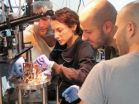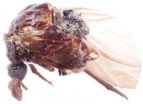(Press-News.org) Washington D.C., July 14, 2014 – A recent study published in the July 2014 issue of the Journal of the American Academy of Child and Adolescent Psychiatry confirms the validity of the DSM-5 change to the age of onset criterion for diagnosis of attention-deficit/hyperactivity disorder (ADHD).
In DSM-5, age of onset criterion for ADHD, previously set at 7 in DSM-IV, has been raised to 12. As explained in DSM-5, age of onset is now set at 12, rather than an earlier age, to reflect the importance of clinical presentation during childhood for accurate diagnosis, while also acknowledging the difficulties in establishing precise childhood onset retrospectively.
Using data from a nationally representative sample of youth who participated in the National Health and Nutrition Examination Survey (NHANES), a group of researchers led by Dr. Kathleen Merikangas of the National Institute of Health Intramural Research Program, evaluated symptoms of ADHD and its subtypes in 1,894 participants aged 12-15 years based on parent reports of symptomatology.
Researchers found that levels of severity, functional impairment, and patterns of comorbidity among the additional 3.46% of children who met all of the ADHD criteria except age of onset under 7 were comparable with those of other mental and behavioral disorders. Although raising the age of onset criterion in DSM-5 from 7 to 12 generated an increase in the prevalence of all subtypes of ADHD, the greatest increase was found for inattention, which tends to have a later onset than symptoms of hyperactivity that emerge earlier in development. Dr. Merikangas noted that youth with the inattention subtype of ADHD are less likely to be recognized and treated because their problems may be less apparent at school and at home. These findings highlight the importance of systematic study of diagnostic criteria in representative samples of the general population.
INFORMATION:
The article "Impact of the DSM-5 ADHD Age of Onset Criterion in the U.S. Adolescent Population" by Jennifer L. Vande Voort, Jian-Ping He, Nicole D. Jameson, and Kathleen R. Merikangas, (http://dx.doi.org/10.1016/j.jaac.2014.03.005) appears in the Journal of the American Academy of Child and Adolescent Psychiatry, Volume 53, Issue 7 (July 2014), published by Elsevier.
A related editorial, "How Evidence on the Developmental Nature of Attention-Deficit/Hyperactivity Disorder Can Increase the Validity and Utility of Diagnostic Criteria," by Drs. Guilherme Polanczyk, and Terrie E. Moffitt, is published in the same issue (http://dx.doi.org/10.1016/j.jaac.2014.04.012).
Funding for this study was supported by the Intramural Research Program of NIMH (Z01 MH002804). The views and opinions expressed in the article are those of the authors and should not be construed to represent the views of any of the sponsoring organizations, agencies, or U.S. government.
Notes for editors
Full text of the article is available to credentialed journalists upon request; contact Mary Billingsley at +1 202 587 9672 or mbillingsley@jaacap.org. Journalists wishing to interview the authors may contact the NIMH Media Office at NIMHpress@mail.nih.gov.
All articles published in JAACAP are embargoed until the day they are published as in press corrected proofs online at http://jaacap.org/inpress. Articles cannot be publicized as in press accepted manuscripts. Contents of the publication should not be released to or by the media or government agencies prior to the embargo date.
About JAACAP
Journal of the American Academy of Child and Adolescent Psychiatry (JAACAP) is the official publication of the American Academy of Child and Adolescent Psychiatry. JAACAP is the leading journal focusing exclusively on today's psychiatric research and treatment of the child and adolescent. Published twelve times per year, each issue is committed to its mission of advancing the science of pediatric mental health and promoting the care of youth and their families.
The journal's purpose is to advance research, clinical practice, and theory in child and adolescent psychiatry. It is interested in manuscripts from diverse viewpoints, including genetic, epidemiological, neurobiological, cognitive, behavioral, psychodynamic, social, cultural, and economic. Studies of diagnostic reliability and validity, psychotherapeutic and psychopharmacological treatment efficacy, and mental health services effectiveness are encouraged. The journal also seeks to promote the well-being of children and families by publishing scholarly papers on such subjects as health policy, legislation, advocacy, culture and society, and service provision as they pertain to the mental health of children and families.
About Elsevier
Elsevier is a world-leading provider of information solutions that enhance the performance of science, health, and technology professionals, empowering them to make better decisions, deliver better care, and sometimes make groundbreaking discoveries that advance the boundaries of knowledge and human progress. Elsevier provides web-based, digital solutions — among them ScienceDirect, Scopus, Elsevier Research Intelligence and ClinicalKey — and publishes nearly 2,200 journals, including The Lancet and Cell, and over 25,000 book titles, including a number of iconic reference works.
The company is part of Reed Elsevier Group PLC, a world-leading provider of professional information solutions in the Science, Medical, Legal and Risk and Business sectors, which is jointly owned by Reed Elsevier PLC and Reed Elsevier NV. The ticker symbols are REN (Euronext Amsterdam), REL (London Stock Exchange), RUK and ENL (New York Stock Exchange).
Media contact
Mary Billingsley
JAACAP Editorial Office
+1 202 587 9672
mbillingsley@jaacap.org
Validity of change in DSM-5 ADHD age of onset criterion confirmed
2014-07-14
ELSE PRESS RELEASES FROM THIS DATE:
'Noisy' memory in schizophrenia
2014-07-14
Philadelphia, PA, July 14, 2014 – The inability to ignore irrelevant stimuli underlies the impaired working memory and cognition often experienced by individuals diagnosed with schizophrenia, reports a new study in the current issue of Biological Psychiatry.
Our brains are usually good at focusing on the information that we are trying to learn and filtering out the "noise" or thoughts that aren't relevant. However, memory impairment in schizophrenia may be related in part to a problem with this filtering process, which Dr. Teal Eich at Columbia University and her colleagues ...
Flashes of light on the superconductor
2014-07-14
Superconductors are futuristic materials that will hopefully have a broad range of technological applications at some time in the future (medical imaging, transport…). Today's use is limited by the extremely low temperatures (close to absolute zero) required for superconductivity to manifest. However, some families of these materials work at "relatively" high temperatures (about - 200° C), and it's on these that scientists are focusing their attention. Among them are copper-based superconductors, which have very unique characteristics. A study conducted by researchers of ...
New theory turns cancer on its head
2014-07-14
A new theory of how cancer works could lead to the next generation of treatments of the disease.
The theory suggests that cancer forms when recently evolved genes are damaged, and cells have to revert to using older, inappropriate genetic pathways.
Astrobiologists Dr Charley Lineweaver from The Australian National University and Professor Paul Davies from Arizona State University teamed up with oncologist Dr Mark Vincent from the University of Western Ontario to develop the new model.
"The rapid proliferation of cancer cells is an ancient, default capability that ...
3D printed anatomy to mark a new era for medical training
2014-07-14
The creators of a unique kit containing anatomical body parts produced by 3D printing say it will revolutionise medical education and training, especially in countries where cadaver use is problematical.
The '3D Printed Anatomy Series', developed by experts from Monash University, is thought to be the first commercially available resource of its kind. The kit contains no human tissue, yet it provides all the major parts of the body required to teach anatomy of the limbs, chest, abdomen, head and neck.
Professor Paul McMenamin, Director of the University's Centre for ...
Physical fitness associated with less pronounced effect of sedentary behavior
2014-07-14
ATLANTA – July 14, 2014 –Physical fitness may buffer some of the adverse health effects of too much sitting, according to a new study by researchers from the American Cancer Society, The Cooper Institute, and the University of Texas. The study appears in the journal Mayo Clinic Proceedings, and finds the association between prolonged sedentary time and obesity and blood markers associated with cardiovascular disease is markedly less pronounced when taking fitness into account.
Sedentary behavior has been linked to an increase risk of obesity, metabolic syndrome, type ...
Domestication syndrome: White patches, baby faces and tameness
2014-07-14
More than 140 years ago, Charles Darwin noticed something peculiar about domesticated mammals. Compared to their wild ancestors, domestic species are more tame, and they also tend to display a suite of other characteristic features, including floppier ears, patches of white fur, and more juvenile faces with smaller jaws. Since Darwin's observations, the explanation for this pattern has proved elusive, but now, in a Perspectives article published in the journal GENETICS, a new hypothesis has been proposed that could explain why breeding for tameness causes changes in such ...
UEA research reveals how cannabis compound could slow tumour growth
2014-07-14
Scientists at the University of East Anglia have shown how the main psychoactive ingredient in cannabis could reduce tumor growth in cancer patients.
Research published today reveals the existence of previously unknown signaling platforms which are responsible for the drug's success in shrinking tumours.
It is hoped that the findings could help develop a synthetic equivalent with anti-cancer properties.
The research was co-led with the Universidad Complutense de Madridin, Spain. The team used samples of human breast cancer cells to induce tumours in mice. They ...
The world's first photonic router
2014-07-14
Weizmann Institute scientists have demonstrated for the first time a photonic router – a quantum device based on a single atom that enables routing of single photons by single photons. This achievement, as reported in Science magazine, is another step toward overcoming the difficulties in building quantum computers.
At the core of the device is an atom that can switch between two states. The state is set just by sending a single particle of light – or photon – from the right or the left via an optical fiber. The atom, in response, then reflects or transmits the next incoming ...
Serendipity at the Smithsonian: The 107-year journey of the beetle Rhipidocyrtus muiri
2014-07-14
Serendipity leads University of Kansas scientists to the discovery and description of Rhipidocyrtus muiri - a 107 year old, lost in collections specimen, which turned out to represent a new genus and species. The long and tortuous history of the enigmatic ripidiine wedge beetle from Borneo is discussed in a recent paper published in the open access journal ZooKeys.
The holotype male, and only known specimen of Rhipidocyrtus muiri, was collected 107 years ago in Borneo but subsequent to this it was transferred among several researchers in the early 1900s. The specimen ...
Best for bees to be stay-at-homes
2014-07-14
Honey bees with roots in the local environment manage much better in the struggle for survival than imported honey bees from foreign environments.
A world without bees would be a whole lot poorer – literally. In Denmark alone an additional 600 million to 1 billion Danish kroner are earned annually due to the work done by bees making honey and pollinating a wide range of crops from apples to cherries and clover.
Unfortunately, bees all over the world are under pressure from pesticides, mites, viruses, bacteria, fungi and environmental changes, among other things. The ...



